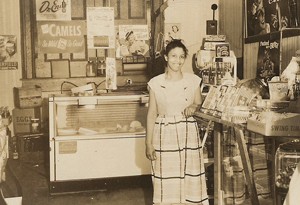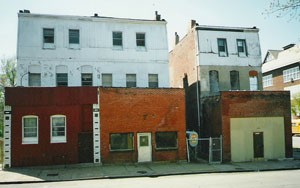
For 40 years, Tillie’s Food Shop operated at the corner of Garrison and Sheridan avenues in the north St. Louis neighborhood of JeffVanderLou. More than a grocery store, the site became a hub of informal activism and community empowerment.
Now, students in a service-learning course at Washington University in St. Louis are working on an application to get the grocery store and its adjacent buildings — better known as “Tillie’s Corner” — on the National Register of Historic Places.
The class, “Building St. Louis History: The City and Its Renaissance,” is taught by Sonia Lee, PhD, assistant professor of history in Arts & Sciences.
Lillie Velma Pearson opened Tillie’s Food Shop in 1948 at a time when black St. Louisans were kept out of white institutions and forced to create their own spheres of commerce, entertainment, religious and cultural life.
Black entrepreneurs often were unable to attract capital outside of their communities and white residents in neighboring areas were unlikely to patronize their businesses.
As crime in the area increased in the 1970s, Pearson refused to leave, believing that her community needed access to high-quality food. The shop’s longevity and reliability was especially important as residents and other businesses left the city.
Pearson died in 2006 at the age of 91. Her granddaughter, Carla Pearson Alexander, and Carla’s husband, Miguel Alexander, still live in the house next to the store. The couple is striving to preserve Pearson’s legacy as a black female entrepreneur and inspiration to many.
Lee says Tillie’s Food Shop is an important example of corner shops that served as a foundation for social cohesion in African-American areas.
To help establish the historical significance of Tillie’s Corner, the WUSTL students hope to meet with former customers, vendors or anyone who may have conducted business with Pearson at an Old Neighborhood Reunion Street Festival at noon Saturday, Sept. 17, in the 2700 block of Howard Street.
Students also are looking for black and/or female small business owners who operated in St. Louis from 1948-1988.
The interviews will be used to build a local archive of black and female-owned St. Louis business history. “We would never learn about the history of Tillie’s Corner without their research,” Lee says, adding that the project is helping students connect to the city.
“They are combining their intellectual interests with community service. They are not just helping the city, as they would through volunteerism, but they are building a body of knowledge that is vital to the city and their own intellectual growth,” says Lee, who received a Faculty Innovation Grant last year from the Gephardt Institute for Public Service at Washington University to develop and implement the community-based teaching and learning course.
Her students also are researching local archival collections as they strive to learn more about Tillie’s Corner and the overarching history of St. Louis urban renewal and preservation. They will start conducting interviews with local residents in early October. Interviews will be ongoing.
Carla Pearson Alexander said she and her husband recently visited the WUSTL students to share “Granny’s story.”

The couple hopes to secure needed funding for renovation by getting Tillie’s Corner on the national register. They recently replaced the roof and a crumbling back wall. With the close proximity of Dunbar Elementary and Vashon High School, they would like to establish a tutoring center on the property as a tribute to Pearson.
“Granny used to say, ‘If I can help just one child, I’ll feel as if I’ve done something right,’” Pearson Alexander says.
Pearson offered credit to customers who could not afford to pay, or temporary employment in exchange for food. She inspired many people to work hard and build their communities, Pearson Alexander says.
All of Pearson’s children, grandchildren, nieces and nephews worked in the store. “As soon as we could reach the cash register, we were working,” Pearson Alexander says. “It was the best hands-on training — learning how to count, read, manage your time, keep records, and everything else. We appreciate the time and love that Granny gave to all of us.”
Pearson’s oldest daughter was nicknamed “Tillie,” and because Pearson liked the name so much, “Tillie’s Food Shop” was born.
“We continue the work to carry out Granny’s vision so her struggles in life and her history won’t go unnoticed,” Pearson Alexander says. “No, these are not just any old buildings. Here is a wonderful story that needs to be told.”
Individuals who would like to be interviewed for the project may contact Lee in the Department of History at (314) 935-6507 or Miguel and Carla Pearson Alexander at (314) 535-2397.